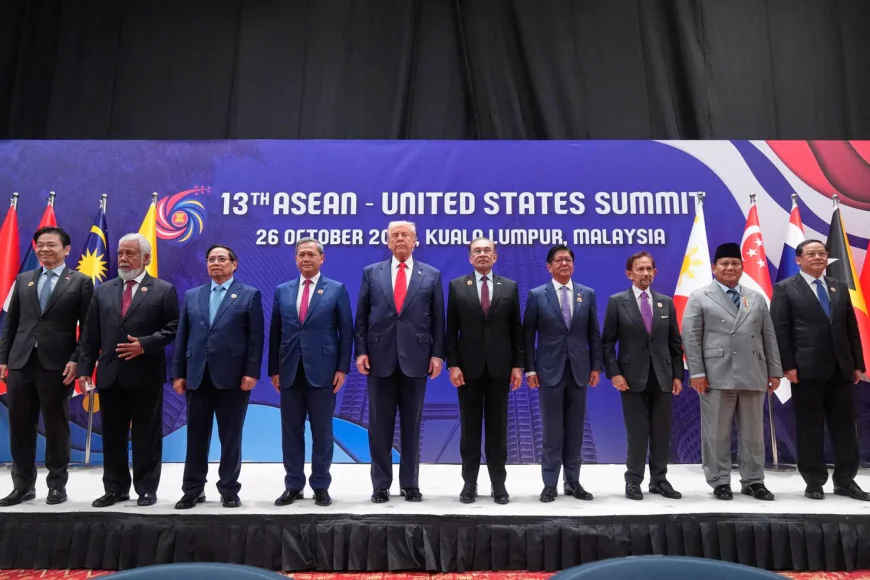Truce or Timeout? Inside President Trump’s U.S.–China Trade Deal and Southeast Asia Pivot
The United States and China have reached a tentative framework trade deal that pauses new tariffs and delays China’s export controls on critical minerals. At the same time, President Donald Trump’s administration has struck a series of trade and minerals agreements with Southeast Asian nations to diversify supply chains and reduce reliance on Chinese dominance in rare earths.

U.S.–China Trade Deal: A Fragile Truce and a Strategic Pivot to Southeast Asia
A delicate balance is taking shape in global trade. As tensions rise between Washington and Beijing, President Donald Trump has announced a temporary truce with China, even as the U.S. forges new alliances across Southeast Asia to secure the minerals and markets essential to its industrial and technological future. The developments, unveiled during high-level meetings around the ASEAN summit in Kuala Lumpur, could reshape economic dependencies across Asia and beyond.
A Step Back from the Brink
The U.S.- China framework deal reportedly halts the steep tariffs that President Trump had threatened to impose up to 100% on Chinese imports beginning November 1. In return, Beijing has agreed to delay its new export licensing regime on rare earths and magnetic materials for at least a year, granting Washington crucial breathing space to strengthen supply chains.
Chinese negotiators have also signaled plans to increase purchases of U.S. agricultural exports, notably soybeans, in a bid to narrow America’s persistent trade deficit. While the full terms remain undisclosed, officials describe the agreement as a “reset,” not a resolution; a pause that allows both economies to reassess their next moves.
Southeast Asia in the Spotlight
On the same weekend, the Trump administration announced multiple trade and critical-minerals agreements with Malaysia, Vietnam, Thailand, and Cambodia. These deals are intended to strengthen commercial ties while reducing dependence on Chinese suppliers.
Malaysia and Cambodia signed reciprocal trade pacts guaranteeing open mineral exports to the United States. Vietnam pledged to expand imports of American goods, while Thailand agreed to cooperate on new supply-chain and investment frameworks. Tariffs on selected exports from these nations will drop, some to zero under the new arrangements.
By cultivating these partnerships, Washington is working to build an alternative minerals network across Southeast Asia, one less vulnerable to Chinese export restrictions and political pressure. For regional economies, the deals promise expanded access to U.S. markets and potential investment in processing and high-tech industries.
Strategic Stakes on Both Sides
Critical minerals such as lithium, cobalt, and rare earths are the backbone of electric vehicles, renewable energy systems, and advanced weapons. China’s dominance in global processing capacity has long been a U.S. strategic concern. By delaying export curbs and engaging in limited trade concessions, Beijing is signaling pragmatism amid Washington’s expanding regional outreach.
For the Trump administration, the move represents a strategic recalibration. Rather than relying solely on tariffs and sanctions, the U.S. is now building a broader network of trade and resource alliances to counter Chinese leverage.
Still, analysts remain cautious. Some warn this could become a “phase-one repeat”, echoing the partial truce of 2020 that later lost momentum. Implementation, not announcement, will determine whether this deal marks a genuine breakthrough or merely a temporary reprieve in a prolonged economic rivalry.
The Road Ahead
Attention now shifts to the upcoming Trump–Xi meeting at the APEC summit in South Korea, where both leaders are expected to review and possibly formalize the framework deal. Markets are closely watching the outcome: shares of rare-earth producers dipped following the announcement, reflecting investor uncertainty about the deal’s longevity.
If implemented effectively, the combination of U.S.–China negotiations and Southeast Asia trade pacts could usher in a new era of strategic interdependence and economic pragmatism. But failure to follow through could reignite tariff battles and deepen the rift between the world’s two largest economies.
Conclusion
The latest trade framework between Washington and Beijing, coupled with the Trump administration’s rapid expansion of economic partnerships across Southeast Asia, signals a temporary easing of global trade tensions and a strategic effort to rewire global supply chains.
Yet beneath the diplomatic veneer lies a hard truth: this is a truce, not a peace treaty. The United States and China remain locked in a fierce contest for technological, economic, and geopolitical dominance. The coming months will determine whether this fragile accord becomes a foundation for stability, or just another pause in an ongoing trade war.
Source:
Reuters,com


